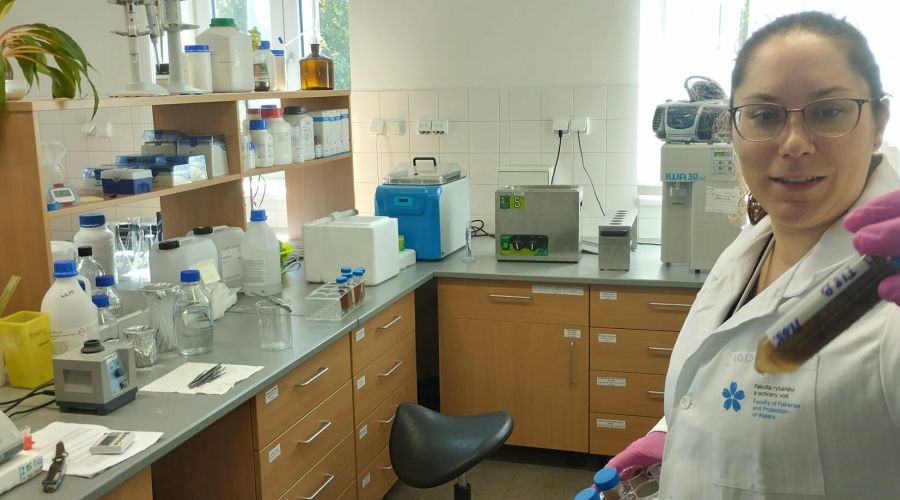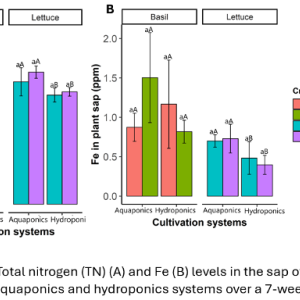TNA project results from the aquaponic greenhouse

Aquaponics is a sustainable food production system that uses nutrient-rich wastes from aquaculture to produce vegetables in hydroponic systems. The nutrients locked in the wastes are converted into absorbable forms for plant use by beneficial microbes present in the cultivation loops. These microbes are also responsible for other biological processes, such as methanogenesis and sulphate reduction, and they contribute to reduced susceptibility to diseases. Dr. Zala Schmautz from the Zurich University of Applied Sciences in Switzerland and Dr. Ewumi Azeez Folorunso from the Laboratory of Nutrition at FFPW USB have completed a TNA that investigated the impact of plant species and cropping systems on the abundance, diversity, and metagenomes of microbial consortia in aquaponic and hydroponic systems. As seen in field studies, plant species are major determinants in the types of microbial communities found in soil rhizobiomes and rhizoplanes (Anthony et al., 2020; Nkongolo & Narendrula-Kotha, 2020). Incessant successes in understanding this natural selection have yielded established sustainable cultivation approaches, such as cereal-legume intercropping, which increases protein yield and reduces the need for nitrogen fertilization.
On the other hand, there is little to no information on the impact of plant species or cropping systems on microbial consortia in soilless systems, such as aquaponics and hydroponics (Schmautz et al., 2022). Understanding the impact of these variables will not only help optimize these systems but also provide a new dimension for addressing challenges such as pests, diseases, and nutrient dynamics in cultivation systems (Folorunso et al., 2021). A strong indication of the impact of plant species and cropping systems on microbial diversity is nutrient uptake by plants in the cultivation systems. For example, iron and nitrogen uptake in plants are products of siderophore activity and nitrification, both of which are biological processes dictated by the present microbial communities in the cultivation systems. In the preliminary results of our study, we have identified significant differences in the uptake of Fe and total nitrogen (among other nutrients) in hydroponics and aquaponics, as well as between basil and lettuce (Figure 1). This may indicate discrepancies in the microbiome across the two cultivation systems and plant species in the expected result of the metagenome. The metagenome result is expected to provide a benchmark for the characterization of microbial communities across the two systems and plant species, and the further manipulation to tackle existing challenges in soilless production systems.
References
Anthony, M. A., Crowther, T. W., Maynard, D. S., van den Hoogen, J., & Averill, C. (2020). Distinct assembly processes and microbial communities constrain soil organic carbon formation. One Earth, 2(4), 349–360. https://www.cell.com/one-earth/pdf/S2590-3322(20)30142-1.pdf
Folorunso, E. A., Roy, K., Gebauer, R., Bohatá, A., & Mraz, J. (2021). Integrated pest and disease management in aquaponics: A metadata-based review. Reviews in Aquaculture, 13(2), 971–995. https://doi.org/10.1111/raq.12508
Nkongolo, K. K., & Narendrula-Kotha, R. (2020). Advances in monitoring soil microbial community dynamic and function. Journal of Applied Genetics, 61(2), 249–263. https://doi.org/10.1007/s13353-020-00549-5
Schmautz, Z., Walser, J.-C., Espinal, C. A., Gartmann, F., Scott, B., Pothier, J. F., Frossard, E., Junge, R., & Smits, T. H. M. (2022). Microbial diversity across compartments in an aquaponic system and its connection to the nitrogen cycle. Science of The Total Environment, 852, 158426. https://doi.org/10.1016/j.scitotenv.2022.158426

